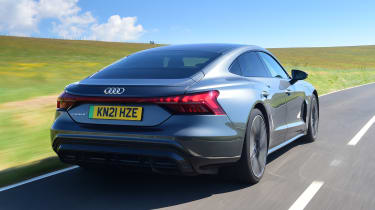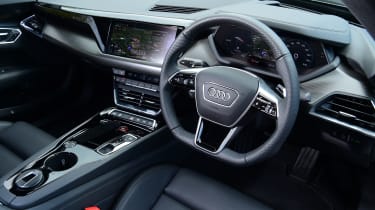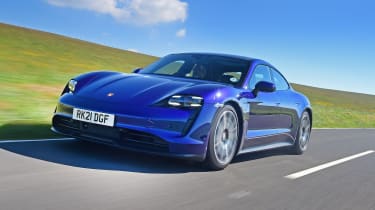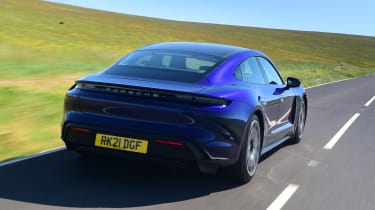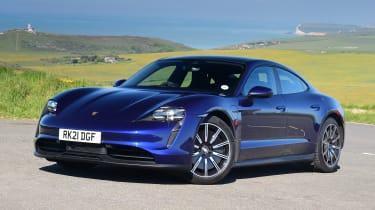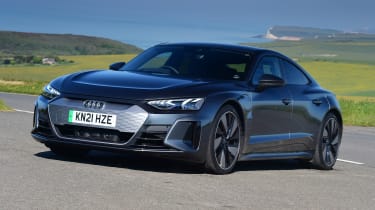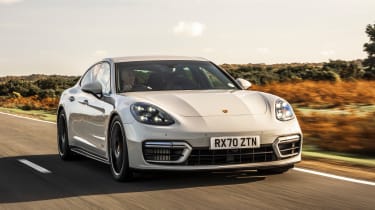If you want an EV but you're also a keen driver, the Audi e-tron GT and Porsche Taycan 4S are tempting propositions – but which is best?
Ask the average petrolhead their thoughts of an electric car, and you’ll probably get some response about how battery power will never match the drama, excitement or thrill of a big, burly petrol engine.
Whether you see EVs as a vital part of the steps needed to strive for cleaner air and reduced emissions, or as a means to spoil your fun, the sooner we can all find EVs which turn those grumbles into grins, the better. Until recently, the complaints were often justified. There were plenty of EVs around that do the everyday stuff well, but were never designed to appeal to a driving enthusiast
New Porsche Taycan RWD 2021 review
On the other hand, there were a couple of high-end EVs that, once you’re over the novelty of neck-snapping acceleration, felt numb and uninvolving to drive.
Then along came Porsche. The Taycan is its first electric effort, and our several encounters have proven that, while it lacks a flat-six engine screaming to 9,000rpm, there’s still plenty for the keen driver to admire.
All of that knowledge and incredible development was carried out together with Audi, and the fruits of its labour, the e-tron GT, is what the Taycan lines up against here. These are truly two of the most dramatic-looking EVs and also two of the best to drive, but which manufacturer has sprinkled the most magic onto the formula?
Audi e-tron GT
| Model: | Audi e-tron GT quattro Vorsprung |
| Price: | £107,300 |
| Powertrain: | 93.4kWh battery/twin motor, 523bhp |
| 0-62mph: | 4.1 seconds |
| Test efficiency: | 2.9m/kWh |
| CO2: | 0g/km |
| Annual road tax: | £0 |
Audi's rapidly growing EV range has the e-tron GT as its flagship. Our quattro model had some non-UK specific extras, including 21-inch alloys. Prices start at £81,200, while this Vorsprung trim’s significant extras raise the price to £107,300.
More reviews
In-depth reviews
- Audi e-tron GT review
Road tests
- New Audi e-tron GT 2021 review
- New Audi RS e-tron GT 2021 review
Design & engineering
The second Audi EV to be launched couldn’t be more different from the first. The big, bulky e-tron SUV places comfort and practicality above all else, and to many people won’t look any different to a combustion-powered Audi, from which its adapted platform is borrowed.
While the e-tron GT has almost the same name, those extra two letters brings a world of difference. For a start, the car’s J1 platform has been developed for pure-electric powertrains from the outset, and as a result, Audi was able to package the motors and battery as efficiently as possible and into a much more dramatically styled package.
The position of the power pack in particular has contributed to the rakish sub-1.4 metre height; the space beneath the rear passenger footwell is free from cells in order to give just a little more room to those in the back. Both the front and rear motors (the e-tron GT is currently four-wheel drive only) are positioned directly between each axle, but the layout is a little unconventional compared with many EVs.
While one motor drives the front wheels as usual, the larger rear motor sends its drive through a two-speed transmission, with a lower gear to help boost acceleration off the line. There’s a combined output of 523bhp and 650Nm, which is enough for a 0-62mph time of 4.1 seconds. Around 80 per cent of buyers are expected to go for this model, but there’s also a performance-focused RS e-tron GT with 637bhp and the 0-62mph time drops to 3.3 seconds.
As standard, the e-tron GT’s suspension set-up features passive springs with adaptive dampers. The Vorsprung model we tested gains air suspension.
Driving
While these are performance cars, first and foremost they need to be easy to use every day. To that end, the ride quality of both of these models is really worth highlighting; both are far more comfortable than their dramatic, low-slung bodies might suggest.
The Audi is the smoother of the two, especially when you consider that our test car rides on 21-inch wheels (not available on UK models) compared with our Porsche’s optional 20-inch items. But the quality of the damping in both, plus their ability to insulate the noise, vibration and harshness, despite the significant weight they both have to deal with
over bumps and potholes, is very impressive.
Of all the minute differences between the two cars, it’s the steering that provides the most obvious point of distinction, because the e-tron GT has four-wheel steering and the Taycan doesn’t. It’s a double-edged sword, though, because while the Audi has a tighter turning circle, at speed the response of the Porsche’s rack is more linear, and the weighing feels ever so slightly more confidence inspiring. We’re nit-picking, though, because the e-tron GT’s rack is right up there with the R8 as the most precise and responsive of any Audi – perhaps ever. It’s well suited to an excellent chassis balance. Grip is phenomenal, which, on a public road at least, means that the e-tron GT rarely feels as hefty as its 2.3-tonne kerbweight suggests. The exception is when braking hard; although the bite is strong and the deceleration reassuring, you can feel the discs and tyres fighting to trim off some significant momentum.
Practicality
One of the benefits of the motors’ compact packaging is that there’s a boot at both ends. Both cars boast an extra 84 litres under the nose, which is perfect for storing charging cables. That’s useful, given that the fairly compact 405-litre load bay at the back has minimal underfloor storage. The rear seats fold down in a 40:20:40 split, giving the opportunity to load longer items through the narrow central opening.
The back seats are very comfortable and supportive, and leg and headroom are okay for adults. Yet those over six feet tall might feel a little cramped – the price you pay for such a low roofline. Foot room under the front seats is very limited. On the plus side, the vertical wireless charging slot in the centre console is very neat, and other storage for smaller items is more generous than in the Taycan.
Ownership
EURO NCAP has yet to assess the e-tron GT yet, but it’s entirely reasonable to assume that it’ll score very similarly to the Taycan. When the Porsche was launched in 2019,
it scored a maximum five-star rating for safety.
Running costs
Buyers will find both cars an absolute bargain to run compared with similarly luxurious combustion cars. Out in the real world, we found that driving style and conditions were much more likely to affect the Audi’s efficiency.
Motorway driving yielded efficiency of roughly 2.4 miles per kilowatt hour, which would result in a range of just over 200 miles. Town driving would probably deliver closer to the official 298-mile range. At best, the Audi showed 251 miles of range at 99 per cent charge. The 2.9-mile/kWh figure we managed would be good for a 243-mile range between top-ups.
Charge at home at the average UK electricity rate (roughly 14p per kWh), and that means it’ll cost just under £1,000 per year to cover 20,000 miles. To match that in a petrol car with fuel costs of £1.35 per litre, you’d need a model to achieve 123mpg.
Things get more tempting for company car drivers. Zero-emission ratings mean that both EVs sit in the lowest Benefit-in-Kind band. As a result, a higher-rate tax payer will face deductions of just £432 (Audi) or £353 (Porsche) per year.
Testers’ notes
“Find the Audi’s black interior a little too moody? Vorsprung models are also available with a choice of red, blueish-grey or brown leather upholstery.”
Porsche Taycan
| Model: | Porsche Taycan 4S Performance Battery Plus |
| Price: | £87,936 |
| Powertrain: | 93.4kWh battery/twin motor, 483bhp |
| 0-62mph: | 3.8 seconds |
| Test efficiency: | 2.9m/kWh |
| CO2: | 0g/km |
| Annual road tax: | £0 |
The Taycan 4S is priced from £84,030. Throw in a lengthy list of optional extras and cosmetic upgrades fitted to this test car, which includes 20-inch wheels (£1,776), a Bose sound system (a
very Porsche-appropriate £956) and the £3,906 Performance Battery Plus (this upgrades the battery capacity from 79.2kWh to 93.4kWh), and the total closely matches the Audi’s list price, at £105,391.
Design & engineering
While these two cars use the same platform, the Taycan is available with a much wider range of motor and battery options than the e-tron GT. The line-up kicks off with a single-motor, rear-wheel-drive model that uses a 79.2kWh battery, starting from £72,850. The range then rolls through the 4S model tested here, a hotter Turbo model and finally the Turbo S. The latter version has a combined output of 751bhp from its two motors, enough for a launch control-assisted 0-62mph time of 2.8 seconds.
While the Audi’s interior feels very concept car-like, the Taycan’s cabin is more traditionally like a Porsche’s – albeit one equipped with the very latest technology. Both cars are stunningly finished and beautifully built, and which one you prefer will come down to personal preference.
Almost everything in the Taycan is controlled via touchscreens. Indeed, the dashboard has just four physical controls: the ignition switch, the gear selector, park button and the hazard-lights switch. The steering wheel has a few more controls, though, including an intuitive rotary switch that cycles through the model’s driving modes.
Since we tested the Taycan, Porsche has tweaked the range slightly, offering what it says is a mildly improved real-world range, although the car’s WLTP data remains unchanged.
Driving
Those drive settings have a profound effect on the way that the Taycan behaves. In Normal mode the ride remains very relaxing – almost as comfortable as the Audi’s. Click into Sport and Sport Plus modes however, and the car hunkers down to the road, the adaptive dampers tense up and suddenly it becomes much sharper – more like you’d expect a Porsche to feel. While it never seems harsh on the road, it feels at least as focused as the most extreme crop of four-door performance cars.
It feels just as fast as them, too. Even though this isn’t the most powerful model in the Taycan range, it feels spectacularly rapid in Sport mode; with the full 563bhp on tap in overboost setting, it’ll cover 0-62mph in just 3.8 seconds – 0.3 seconds faster than the Audi e-tron GT. The instant throttle response and surge at any speed mean that it’s a hugely effective tool, whether accelerating out of corners or when executing an overtake.
Unsurprisingly, the differences in the way the Audi and Porsche drive are very subtle. It’s all in the finer details; for example, the Taycan’s brakes feel easier to modulate, especially at slow speeds. Yet neither car is able to come to the seamlessly smooth stop possible in a Tesla Model S. From higher speeds, there is a noticeable transition at the point in the pedal where the brake regeneration reaches its limit and the brake pads begin to grab the discs. Here again, the Porsche seems to be more finely tuned.
Practicality
Both the Taycan and the e-tron GT are best considered as four-seaters. It is possible to add a fifth seat – it’s a £336 option for the Taycan – but it’s only really of use for small kids. It’s narrow and firm, and its jacked- up position severely limits headroom.
Life in the two outer seats is much better, and accommodation in the Porsche is nearly identical to the Audi. Rear-seat passengers in both cars can also make use of two USB-C ports to charge their devices.
One disadvantage of this pair is their width. Even with the side mirrors folded, both of these cars are nearly two metres wide. It means that on certain B-roads and tight city streets, there’s always a level of caution required. It’s a shame because by all other measures, both the Audi and the Porsche do very well in both of those environments.
Ownership
From an ownership point of view, Porsche has set a standard that other manufacturers can aspire to. In our 2021 Driver Power survey, our readers rated Porsche’s cars more satisfying to own than any other brand.
The excellent work was continued by its dealers, too. The aftersales service was rated third best out of 21 manufacturers’ dealerships. By contrast, Audi was ranked 23rd of the 29 makers assessed, and its dealers took 18th place out of 21 networks.
Running costs
The Taycan and the e-tron GT cling on to their value exceptionally well when compared with similarly priced combustion vehicles, but the Taycan’s residuals are particularly remarkable. After three years and 36,000 miles, the 4S is expected to retain nearly 75 per cent of the £84,030 asking price; that means it’ll still be worth almost £63,000 after all that use.
It’s worth bearing in mind that the estimated figure doesn’t take into account the options added to this car. On the other hand, the most expensive model in the range, the £140,000 Taycan Cross Turismo Turbo S, maintains an even greater 82 per cent of its original value after three years.
Beside the Porsche, the e-tron GT’s residual values of 60.1 per cent appear less impressive. However, that figure needs some context; compare it with the similarly priced Audi RS 7 Sportback (which retains roughly 50 per cent of it price when new) or the A8 (at best 45 per cent for the S8, and as little as 32 per cent) depreciation is still slow.
Testers’ notes
“For those who hanker after a little more space in the Porsche, the Taycan Cross Turismo packs all the same electric technology into a stunning shooting brake bodystyle.”
Verdict
First place: Porsche Taycan
With the Taycan 4S, Porsche has without doubt produced one of the most convincing EVs to date. Yes, the Turbo and Turbo S models are even quicker, but this model is more than fast enough. Throw in a brilliant chassis, excellent refinement, a slick infotainment system and tiny running costs for what’s on offer, and it’s a top all-rounder. It proves that electric can most certainly be fun.
Second place: Audi e-tron
It settles for second best here, but the Audi e-tron GT is still one of the best EVs on sale. It’s more comfortable than the Porsche, the in-car tech is even better, and it’s similarly rapid and efficient in the real world. However, the Porsche’s superior residuals deliver lower monthly payments, and the better feedback from owners suggest it’ll be the better car to live with.
Also consider…
Audi RS7
- Model: Audi RS 7 Sportback
- Price: £100,055
- Engine: 4.0-litre turbo V8, 592bhp
Performance EV rivals are hard to come by, but Porsche and Audi both offer similarly quick combustion alternatives. The RS 7 has storming pace and exceptional traction from its 4WD system, but has a brawnier styling and a more spacious cabin than the e-tron GT.
Porsche Panamera
- Model: Porsche Panamera GTS
- Price: £107,880
- Engine: 4.0-litre turbo V8, 476bhp
In many ways the Panamera remains a world-beating practical performance car. Its agility is more hot hatch than five-metre limousine, and in GTS form it’s at its most thrilling to drive. If you’re not ready to go full EV, there’s even a choice of plug-in hybrid powertrains.
Figures
| Porsche Taycan 4S Performance Battery Plus | Audi e-tron GT quattro Vorsprung | |
| On the road price/total as tested | £87,936/£105,391 | £107,300/£108,250 |
| Residual value (after 3yrs/36,000) | £65,706/74.7% | £64,444/60.1% |
| Depreciation | £22,230 | £42,856 |
| Annual tax liability std./higher rate | £177/£353 | £216/£432 |
| Annual elec. cost (12k/20k miles) | £596/£993 | £596/£993 |
| Insurance group/quote/road tax cost | 50/£1,781/£0 | 50/£2,125/£0 |
| Servicing costs | N/A | £880 (3 years) |
| Length/wheelbase | 4,963/2,900mm | 4,989/2,900mm |
| Height/width | 1,379/1,966mm | 1,396/1,964mm |
| Powertrain | 2 electric motors/lithium-ion battery | 2 electric motors/lithium-ion battery |
| Peak power/overboost | 483/563bhp | 523bhp/N/A |
| Peak torque | 650Nm | 640Nm |
| Transmission | 2-speed auto/4WD | 2-speed auto/4WD |
| Battery capacity/usable | 93.4/83.7kWh | 93.4/83.7kWh |
| Boot capacity (front/rear) | 84/407 litres | 84/405 litres |
| Kerbweight/payload/towing capacity | 2,220/660kg/N/A | 2,347/513kg/N/A |
| Turning circle | 11.7 metres | 11.6 metres |
| Basic warranty (miles)/recovery | 3 yrs (unlimited)/1 yr | 3 yrs (60,000)/3 yrs |
| Driver Power manufacturer/dealer pos. | 1st/1st | 23rd/18th |
| NCAP: Adult/child/ped./assist/stars | 85/83/70/73/5 (2019) | N/A |
| 0-62mph/top speed | 3.8 secs/155mph | 4.1 secs/152mph |
| Auto Express economy (miles/kWh) | 2.9 | 2.9 |
| Auto Express predicted range | 243 miles | 243 miles |
| Claimed range (WLTP) | 283 miles | 298 miles |
| Charging capability | 11/270kW | 11/270kW |
| Charging time | 9 hours (0-100%)/23 mins (5-80%) | 9 hours (0-100%)/23 mins (5-80%) |
| Actual/claimed CO2/tax bracket | 0/0g/km/1% | 0/0g/km/1% |
| Airbags/Isofix/parking sensors/cam. | Eight/yes/yes/yes | Eight/yes/yes/yes |
| Auto/lane keep/blind spot/AEB | Yes/yes/yes/yes | Yes/yes/yes/yes |
| Clim./cruise ctrl/leather/heated seats | Yes/yes/part*/yes | Yes/yes/yes/yes |
| Met paint/LEDs/keyless/pwr tailgate | £774/yes/yes/yes | £950/yes/yes/yes |
| Nav/digi dash/DAB/connected apps | Yes/yes/yes/yes | Yes/yes/yes/yes |
| Wireless charge/CarPlay/Android Auto | Yes/yes/yes | Yes/yes/yes |
Next Steps
Source: Read Full Article


 New Porsche Taycan RWD 2021 review
New Porsche Taycan RWD 2021 review
